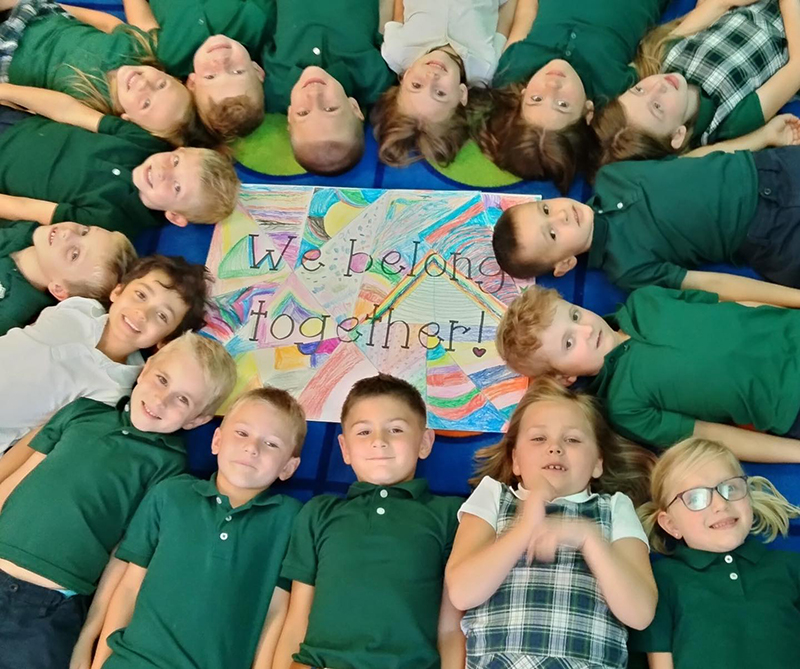
Beth Juranek’s first-grade class at St. Patrick School in Hudson takes a picture after completing the puzzle phrase “We belong together.” (Submitted photo)
Jenny Snarski
Catholic Herald staff
As Catholic schools across the diocese launch into a new school year, Diocese of Superior Superintendent of Schools Peggy Schoenfuss said new staff, the incorporation of a new Theology of the Body curriculum and progress in schools’ ongoing accreditation process are among this year’s highlights.
New staff, principals
With more than 30 new teachers hired across the diocese, Schoenfuss said it was “the most we’ve seen in a long time.”
She added, “For more than 10 years, we’ve seen a decline in teacher applicants in our schools. The past two years have accelerated this issue. We have many teachers who have left our schools to pursue other careers or positions within the public schools, where there is also a shortage of teachers.”
Among the new teachers hired, some are second-career teachers coming from the public schools, and some individuals are coming from other careers, having discovered a love of teaching.
“We have some new teachers just out of college,” Schoenfuss commented. “Catholic education is a calling for them, and they see this missionary call as a gift of sacrifice for the faith.”
St. Francis Xavier School in Merrill is one of the schools welcoming a new principal. Kate Shimel has been a teacher at the school for more than 10 years; she acted as co-teacher-in-charge last school year and stepped into the principal role for 2022-2023.
“She is very thankful for all the teachers at St. Francis for their teamwork and willingness to help lead the school in any way they can,” Schoenfuss said.
Holly Bacha, who has a history of teaching in area public schools, began at Our Lady of Sorrows in Ladysmith last spring, going through the practicum for her special education licensure.
Bacha loves the small, caring, and family-friendly atmosphere at OLS.
“With so many new teachers and students at OLS this year, Holly is excited to be learning about the traditions of OLS along with all the new families,” Schoenfuss said.
St. Mary’s in Tomahawk has Juanita Skubal acting as teacher-in-charge, as the school was unable to secure a principal due to lack of applicants.
Schoenfuss said that while the school continues to search for the right candidate to fill the principal position, Skubal – an alumnus and teacher at St. Mary’s for over 20 years – “had a great love and passion for the families and children at the school and parish.”
Theology of the Body curriculum
Ruah Woods Institute is a formation institute that serves the Catholic community by applying Theology of the Body to our everyday lives, becoming, as Schoenfuss explained, more of the sons and daughters God created us to be.
“In our world today, there is much confusion about who we are as human beings and how, as humans, we fit into the world around us,” Schoenfuss said. “As sons and daughters of God, our creator and Father, we have a particular role in our world.
“To make right the confusion, Bishop Powers has asked all schools to implement the Ruah Woods curriculum for grades K-8,” she added, noting there are also some parishes who are adopting this curriculum this year.
This foundational curriculum equips teachers and parents with church-approved tools for forming boys and girls in their God-given identity. Pope St. John Paul II’s Theology of the Body is brought into context of the modern world. Through this curriculum, children will gain an understanding of who God is, who they are as image-bearers of God, and how they fit into the world.
Schoenfuss continued, “This curriculum is not a chastity program focused on human sexuality with a bunch of rules. It is a program that emphasizes our creation in God’s image as a gift and how we live that gift out in our lives. Children we become more aware of their own dignity as well as the dignity of others.”
In addition to the K-8 curriculum, teachers will participate in the Ruah Woods TOB Campus.
Teachers will be learning, embracing and sharing their own stories of living in God’s image through nine small group formation sessions and discussions. These sessions will increase their knowledge of the faith as illuminated by the Theology of the Body; increase their relationships with one another through small group activities and discussions; and deepen their relationship with Jesus Christ through guided Scripture reflections.
Accreditation process
This school year, there are eight schools at various stages of the accreditation process through the Wisconsin Religious and Independent Schools Accreditation. Four schools are conducting their self-study, and another four are going through the visiting team process.
WRISA is a nonprofit organization that began in 1991 to provide non-public schools in Wisconsin with an ongoing school improvement process. Schoenfuss stated that all 14 schools in the Diocese of Superior have been accredited since the late-1990s to early-2000s with this organization.
Every six years, each school goes through a self-study where teams of individuals study the workings of the school – particularly in the areas of mission and Catholic identity, governance and leadership, academic excellence and operational vitality. All Catholic schools in Wisconsin utilize the National Standards and Benchmarks for Effective Catholic Elementary and Secondary Schools – consisting of 13 standards and 70 benchmarks – for this accreditation process.
On the seventh year, a team of educators visits the school for 48-60 hours and validates the self-study of the school. Through this validation, all areas are reviewed through artifacts, observation or interviews.
The team may provide recommendations for improvement to assist the school in moving forward. Following this visit, the school must write goals for each area of the study, so that there is continual improvement. Sometimes there are immediate improvements that must be made to reach accredited status, but usually these things are caught during the school’s study of itself. The WRISA board issues the accreditation status.
